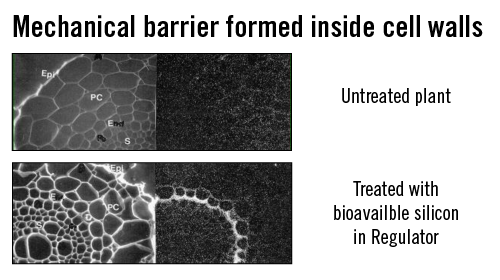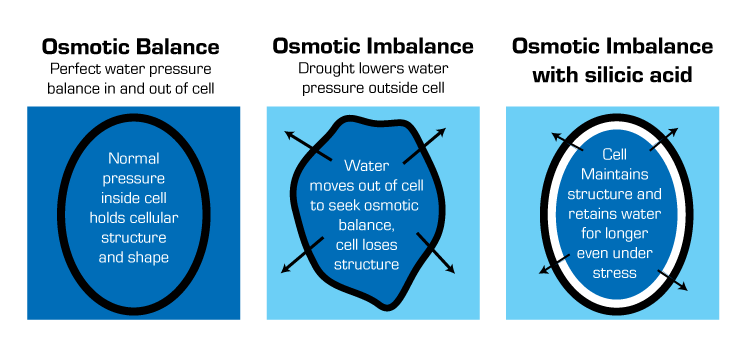Silicon & Silicic Acid
What do you think about when you hear “Silicon”? Is it breast implants? Well, that’s far from the only use of the second most abundant element on earth. Silicon is found in things like glass, concrete, porcelain and electronics. It’s used in agricultural fertilizers too.
Silicon has only recently been classified as a beneficial plant nutrient. Even though it’s not considered essential to plant development, the effects of (bioavailable) silicon in plants are remarkable. Large numbers of growers are familiar with the benefits of including it in their feeding regimen. These benefits include resistance to stress, immune system boost, and increased nutrient uptake.
Silicon is everywhere but is generally unavailable to plants. In nature, microbes convert unavailable forms of silicon into (mono)silicic acid – the only (!) bioavailable form of silicon. This process is slow and depends on many factors. That means a grower may add silicon additives but not experience the true power of growing with silicon.
So, in its most common forms silicon is not readily absorbed into biological tissues. Take potassium silicates as an example. Its molecules are too large to penetrate our plants cell walls. Microbes will have to convert it into silicic acid before the roots can take up the silicon. This process is called silicification, and it can take weeks or months before it occurs in any meaningful amount.
For most applications however, speed and bioavailability are critical. Crops are often harvested in a matter of weeks or a couple months, after which growing substrates are often discarded or sterilized. This destroys the micro-life populations and minimizes the silicification process.
Silicic acid is therefore the most effective silicon additive since it’s 100% bioavailable. And not all silicic acid is created equal! In nature, silica exists in polymer form because it is stable. These are long chains of molecules. In order for plants to use silicic acid it must be in monomer form (single molecule, mono-silicic acid).
Aptus Regulator, our flagship product, contains this mono-silicic acid in high concentrations in a stabilized form. We were the first to bring a stabilized mono-silicic acid product to market, and since then quite a few competitors have tried to reproduce it. But, without success. Aptus Regulator is still the only true mono-silicic acid. The one to rule them all!
When added to clean water, the monomer is activated allowing it to enter plant, carrying nutrients with it. Over time silicic acid will recombine with itself in polymer form, which is why it’s important to mix fresh nutrients and feed immediately.
Mono-silicic acid has three primary effects on plants:
- Mechanical – Builds structure and resistance to stress
Deposits silicon directly into the outer layer of the cell creating a rigid barrier and a more solid structure. - Nutritional – Increased and more balanced uptake of nutrients
Pressurizes the plant sap to allow a better and more even flow of nutrients throughout the plant circulatory system. - Immunity – Stimulates plant’s immune system
Triggers the production of immunity compounds, as well as drawing silicon to the point of attack to rebuild and strengthen tissue.
1. MECHANICAL
Silicon is deposited in the cell walls creating a strong, rigid structure, much like a brick wall cemented together. Cells are able to maintain their shape amid  environmental attacks. When the wind blows and bends a stem in one direction, cells on the downwind side are compressed. Silicon makes firmer cells that compress less when bent.
environmental attacks. When the wind blows and bends a stem in one direction, cells on the downwind side are compressed. Silicon makes firmer cells that compress less when bent.
In the case of drought, stronger cell walls are better at maintaining water balance inside the cells. Imagine filling a water balloon – the balloon is firm and taught. Then, as you deflate, the skin of the balloon becomes soft and yielding. This is why dry plants droop. Stronger cells keep their structural integrity for longer.
2. NUTRITIONAL
Mono-silicic acid has a remarkable effect on the uptake of other nutrients. Think of it as a train engine that helps pull other “cars” through the plant sap. Mono-silicic acid is particularly good at increasing the transport of heavy, immobile minerals like calcium.
When present, mono-silicic acid increases the pressure of the vascular system (like our own circulatory system). Imagine a hose filled with tiny particles of sand (nutrients). If a trickle of water (plant sap) moves through the hose, most of the particles stay put. If the water pressure is increased to a heavy flow, more of the sand particles are pushed through the hose.
Plants don’t have muscles in the same way we do. Instead, elements are moved around the plant by suction, pressure and molecular interaction. Lower pressure, created by synthetic fertilizers and overwatering, makes heavier molecules less mobile. By increasing the pressure, minerals are more easily carried throughout the plant.
With higher internal pressure inside all other minerals, in various forms, are more easily moved throughout the plant to where they are required. This vascular pressure is especially important for larger plants with more branching as more energy is required to move nutrients along these complex and far-reaching pathways.
3. IMMUNITY
Attacking insects must somehow puncture the wall of the plant “skin” in order to suck the fluid, eat the tissue or burrow inside. By increasing the thickness of the cell walls, with silicon deposits, many of these tiny insects are unable to break the surface of the cell.
When it comes to pathogens, like fungi, it’s important to understand that silica doesn’t kill the pathogen but rather makes the plant inhospitable to the pathogen. By blocking fungal spores from attaching, the plant maintains its health and strength. This is the best, most natural, preventative approach.
There’s also compelling studies that show plants move extra silicic acid to points of attack and stress such as insects, fungi or breakage. This is much like when we get a cut and platelets in our blood rush to the cut to create a clot while the wound heals. The additional silicon deposits create even stronger tissue.
SUMMARY
Looking at the total picture, we can draw the conclusion that plant that frequently enjoyed a sufficient dose of mono-silicic acid:
- Have stronger and thicker branches
- Carry sturdier fruits with higher nutritional value and a longer shelf-life
- Are practically invulnerable to attacks by pests or fungi
- Are more resistant to high temperatures
- Are more resistant to stress caused by high concentrations of salts in the substrate (high EC)
- Have a higher brix-level and higher mineral content
- Are better and more equally mineralised, which minimizes the chance of plant deficiencies
- Give a higher yield







